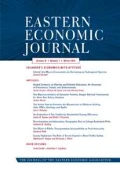Abstract
The market for modern Indian art is an emerging art market, having come into a proper existence only in the late 1990s. This market saw tremendous growth in its initial years, then a downturn that started around 2007–2008. Using data from auctions conducted by a major Indian art auctioneer, we estimate via hedonic regression a price index for paintings and drawings by Indian artists sold during 2000–2013. We are able to thus estimate a rate of return on Indian art as an investment and also shed light on what drives the price of a painting in the Indian market.

Similar content being viewed by others
Notes
See for instance papers by Anderson [1974], Frey and Pommerehne [1989], Buelens and Ginsburgh [1993], de la Barre et al. [1994], Chanel et al. [1994], Czujack [1997], and Renneboog and Spaenjers [2013].
Reddy and Dass [2006] focus on a single Saffronart auction in December 2004 for 107 paintings to understand within-auction price dynamics. Their work complements ours, since we focus on trends in auction prices over time.
Having online auctions allows Saffronart to tap into the non-resident Indians (NRIs) consumer base. While about 60 percent of Saffronart’s buyers are based in India, NRIs constitute the bulk of the remaining 40 percent. More generally, online auctions are a growing trend in the art world, and several international art auction houses have experimented with this format in recent years [Gameran and Crow 2011].
We chose INR for the regressions since the majority of Saffronart’s buyers are either based in India or have substantial financial assets located there.
In the case of contemporary painters, it is less clear who the established painters in the coming years will be.
Since all contemporary artists in our data set are still alive, this coefficient is estimated only in the modern artists sample.
In general, art prices were booming globally during 2002–2007. Renneboog and Spaenjers [2013] report an annual real growth in Western art prices of 13.65 percent during this time.
References
Anderson, Robert C. 1974. Paintings as an Investment. Economic Inquiry, 12 (1): 13–26.
Ashenfelter, Orley, and Kathryn Graddy . 2006. Art Auctions. in Handbook of the Economics of Art and Culture. Vol. 1, edited by Victor A. Ginsburgh, and David Throsby. Northampton, MA: Elsevier, 909–945.
Buelens, Nathalie, and Victor Ginsburgh . 1993. Revisiting Baumol’s “Art as Floating Crap Game”. European Economic Review, 37 (7): 1351–1371.
Campbell, Rachel . 2008. Art as a Financial Investment. The Journal of Alternative Investments, 10 (4): 64–81.
Chanel, Olivier, Louis-Andre Gerard-Varet, and Victor Ginsburgh . 1994. Prices and Returns on Paintings: An Exercise on How to Price the Priceless. The Geneva Papers on Risk and Insurance Theory, 19 (1): 7–21.
Czujack, Corinna . 1997. Picasso Paintings at Auction: 1963–1994. Journal of Cultural Economics, 21 (3): 229–247.
de la Barre, Madeleine, Sophie Docclo, and Victor Ginsburgh . 1994. Returns of Impressionist, Modern and Contemporary European Paintings 1962–1991. Annales d’Economie et de Statistique, 35: 143–181.
Ford, Peter . 2009. As Chinese Art Market Crashes, Many Artists Applaud. Christian Science Monitor (April 7).
Frey, Bruno S., and Werner W. Pommerehne . 1989. Art Investment: An Empirical Inquiry. Southern Economic Journal, 56 (2): 396–409.
Gameran, Ellen, and Kelly Crow . 2011. Clicking on a Masterpiece. The Wall Street Journal (WSJ.com) (January 14).
Hawkins, Jenny R., and Viplav Saini . 2014. Returns on Indian Art during 2000–2013. ACEI Working Paper Series, May.
Khaire, Mukti, and R. Daniel Wadhwani . 2010. Changing Landscapes: The Construction of Meaning and Value in a New Market Category — Modern Indian Art. Academy of Management Journal, 53 (6): 1281–1304.
Peers, Alexandra . 2008. The Fine Art of Surviving the Crash in Auction Prices. The Wall Street Journal (WSJ.com) (November 20).
Reddy, Srinivas K., and Mayukh Dass . 2006. Modeling On-line Art Auction Dynamics Using Functional Data Analysis. Statistical Science, 21 (2): 179–193.
Renneboog, Luc, and Christophe Spaenjers . 2013. Buying Beauty: On Prices and Returns in the Art Market. Management Science, 59 (1): 36–53.
Robertson, Iain . 2011. The Art Market in Transition, the Global Economic Crisis, and the Rise of Asia. in Globalization and Contemporary Art, edited by Jonathan Harris. West Sussex, UK: Wiley-Blackwell, 449–463.
Acknowledgements
We thank Saffronart COO Nish Bhutani and his team members Vipin Jain, Punya Nagpal, and Yamini Telkar for their help with the data and their insights about the Indian art market. We appreciate advice and feedback from Tobias Pfutze, Eesha Phanse, Shashank Saini, and the audience and discussants at the Southern Economic Association annual meetings. Yiqin Chen provided competent research assistance. Research support from the Albert Rees fund and the H.H. Powers grant at Oberlin College is gratefully acknowledged.
Author information
Authors and Affiliations
Rights and permissions
About this article
Cite this article
Hawkins, J., Saini, V. Returns on Indian Art during 2000–2013. Eastern Econ J 42, 302–310 (2016). https://doi.org/10.1057/eej.2015.39
Published:
Issue Date:
DOI: https://doi.org/10.1057/eej.2015.39


